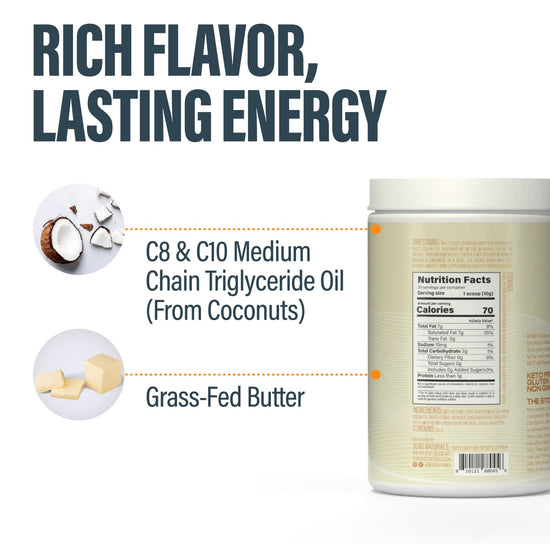Table of Contents
- Introduction
- The History of Non-Dairy Creamers
- What Ingredients are in Non-Dairy Creamers?
- How to Use Non-Dairy Creamer
- Health Considerations: Are Non-Dairy Creamers Good for You?
- Alternatives to Non-Dairy Creamers
- BUBS Naturals’ Commitment to Clean Ingredients
- Conclusion
- FAQ
Introduction
If you’ve ever stood in the coffee aisle at your local grocery store, you may have been overwhelmed by the numerous options for creamers, particularly non-dairy creamers. What exactly is non-dairy creamer, and why has it become such a popular choice for many coffee lovers? As the demand for lactose-free and plant-based products continues to rise, understanding non-dairy creamers is more relevant than ever.
Historically, non-dairy creamers were developed to provide an alternative for those who cannot consume dairy products. However, many non-dairy creamers still contain milk-derived ingredients, which creates confusion among consumers. In this blog post, we will explore the origins, ingredients, and various uses of non-dairy creamers, as well as provide healthier alternatives and our insights into making informed choices.
By the end of this post, you’ll have a comprehensive understanding of non-dairy creamers—what they are, how they’re made, and whether they’re suitable for your lifestyle. We’ll also delve into the various flavors and types available, and consider how BUBS Naturals' mission aligns with the growing demand for clean, functional dietary alternatives. Let’s dive in and explore the world of non-dairy creamers!
The History of Non-Dairy Creamers
To understand non-dairy creamers, we first need to look at their history. The evolution of non-dairy creamers began in the 1940s when food scientists were experimenting with soy protein. Holton "Rex" Diamond, an employee of Rich Products, conducted experiments from 1943 to 1945 to create a "soy cream" that wouldn’t separate in coffee. This pioneering work laid the foundation for what we now refer to as non-dairy creamer.
By the 1950s, several commercial non-dairy creamers came onto the market, including "Mocha Mix," which was the first commercial non-dairy creamer introduced. Other products like Coffee-Mate followed suit, leading to a boom in the availability of creamers that catered to various tastes and dietary needs.
As consumer demand evolved, so did the formulations of non-dairy creamers. They transitioned from basic soy-based options to more complex mixtures containing a variety of ingredients designed to replicate the taste and texture of dairy cream. Today, non-dairy creamers are available in various flavors, including vanilla, hazelnut, and even seasonal varieties like pumpkin spice.
What Ingredients are in Non-Dairy Creamers?
The ingredients in non-dairy creamers can vary significantly depending on the brand and formulation. Here, we’ll break down some common components found in many non-dairy creamers.
1. Vegetable Oils
Most non-dairy creamers are formulated with hydrogenated vegetable oils to create a creamy texture. These oils mimic the mouthfeel of dairy fats, allowing for a smooth addition to beverages. Common oils used include palm oil, soybean oil, and coconut oil. However, consumers should be aware that some hydrogenated oils may contain trans fats, which are linked to various health concerns.
2. Sodium Caseinate
This is a milk-derived protein that is often included in non-dairy creamers to enhance creaminess. While sodium caseinate does not contain lactose, it may not be suitable for those with milk allergies or those following strict vegan diets. This ingredient is often a point of confusion, as many consumers assume "non-dairy" means completely free of dairy components.
3. Sweeteners and Flavorings
To enhance the taste of non-dairy creamers, manufacturers frequently add sweeteners and flavorings. This can include sugar, high fructose corn syrup, or artificial sweeteners. Popular flavorings include vanilla, hazelnut, and caramel, which can significantly alter the taste profile of the creamer.
4. Stabilizers and Emulsifiers
To ensure that non-dairy creamers mix well with liquids and maintain a consistent texture, manufacturers often add stabilizers and emulsifiers. Ingredients like gellan gum, guar gum, and carrageenan help keep the components evenly distributed and prevent separation.
How to Use Non-Dairy Creamer
Non-dairy creamers are incredibly versatile and can be used in various ways beyond just coffee. Here are some common applications:
1. Coffee and Tea
The most popular use for non-dairy creamers is as a coffee additive. They can enhance the flavor and texture of coffee, making it creamier without the use of dairy products. Non-dairy creamers can also be used in tea, hot chocolate, or other hot beverages to add richness.
2. Baking and Cooking
Non-dairy creamers can be incorporated into recipes for baked goods, sauces, and soups. They can replace dairy cream in recipes, providing a similar texture while maintaining a dairy-free profile. This versatility makes them an excellent choice for those with dietary restrictions.
3. Smoothies and Protein Shakes
For those looking to add creaminess to smoothies or protein shakes, non-dairy creamers can be mixed in to enhance flavor and texture. They can be particularly beneficial in vegan or lactose-free recipes.
Health Considerations: Are Non-Dairy Creamers Good for You?
As with any processed food product, the health implications of non-dairy creamers can vary based on individual dietary needs and preferences. Here are some considerations to keep in mind:
1. Nutrition Labels Matter
It’s essential to read nutrition labels when selecting a non-dairy creamer. Some options may contain high levels of sugar, unhealthy fats, or artificial additives. Opting for creamers with fewer ingredients and those that are minimally processed is generally a better choice.
2. Dietary Restrictions
For individuals with lactose intolerance or dairy allergies, non-dairy creamers can provide a suitable alternative. However, those with soy allergies should avoid creamers containing soy-based ingredients. Always check labels for allergens.
3. Plant-Based Alternatives
As the demand for plant-based products grows, many brands are now offering non-dairy creamers made from nuts, oats, and coconut. These alternatives often contain healthier fats and fewer additives, making them a smart choice for health-conscious consumers.
Alternatives to Non-Dairy Creamers
If you’re looking for alternatives to traditional non-dairy creamers, consider the following options:
1. Nut Milks
Almond, cashew, and macadamia nut milks can serve as excellent substitutes for non-dairy creamers. They provide a creamy texture without the additives found in many processed creamers.
2. Oat Milk
Oat milk has gained popularity for its rich, creamy texture that closely resembles dairy milk. It’s a great option for coffee, baking, and cooking.
3. Coconut Cream
For those looking for a richer alternative, coconut cream offers a thick, creamy texture that can enhance coffee and desserts.
4. Homemade Creamers
Crafting your own non-dairy creamer at home can be a fun and rewarding experience. By blending ingredients like coconut milk, almond milk, or cashew cream with natural sweeteners and flavorings, you can create a personalized creamer that meets your dietary needs.
BUBS Naturals’ Commitment to Clean Ingredients
At BUBS Naturals, we share a commitment to clean, functional nutrition. Our products are rigorously tested and certified, ensuring that you receive the highest quality ingredients without unnecessary additives. We believe in providing options that support your active lifestyle while adhering to our values of simplicity and effectiveness.
If you’re looking for ways to enhance your wellness journey, consider exploring our Collagen Peptides, which are designed to support joint, skin, and recovery health. Our MCT Oil Powder is another excellent choice for those seeking sustained energy and mental clarity. We invite you to browse our full line of products here.
Conclusion
Non-dairy creamers have come a long way since their inception, evolving into a diverse range of options to accommodate various dietary needs and preferences. Understanding what non-dairy creamers are, their ingredients, and how to use them can empower you to make informed choices.
As we continue to prioritize wellness and clean living, it’s important to explore alternatives and products that align with our values. By choosing clean, functional supplements like those from BUBS Naturals, you can support your health and well-being while enjoying the flavors you love.
FAQ
1. Are non-dairy creamers vegan?
Not all non-dairy creamers are vegan, as some contain sodium caseinate, a milk derivative. Always check ingredient labels for clarity.
2. Can non-dairy creamers be used in baking?
Yes, non-dairy creamers can be used in baking and cooking as a substitute for dairy cream, providing a similar texture and flavor.
3. How long do non-dairy creamers last?
Liquid non-dairy creamers should be refrigerated after opening and typically last for about 7-10 days. Powdered creamers have a longer shelf life and can be stored in a cool, dry place.
4. What are the healthiest non-dairy creamers?
Look for non-dairy creamers with minimal ingredients, natural sweeteners, and those that are low in added sugars and unhealthy fats.
5. How do I choose the right non-dairy creamer for my coffee?
Consider your taste preferences, dietary needs, and ingredient quality when selecting a non-dairy creamer. Taste testing different brands can also help you find your favorite.
Written by:

Butter MCT Oil Creamer
BUBS Butter MCT Oil Creamer (formerly Halo Creamer): Scientifically-Backed Brain and Body Fuel
BUBS Butter MCT Oil Creamer is your go-to for clean, fast-acting energy and focus, no crash included. It blends creamy grass-fed butter with fast-acting MCT oil powder (C8 and C10) to kickstart your day and keep you sharp. The MCTs go straight to work, giving your brain a quick boost while the grass-fed butter supports digestion and gut health.
Together, they help curb cravings, keep you feeling full longer, and support steady energy throughout the day—perfect for fueling your mornings or powering through the afternoon slump.
Starts at $36.00
Shop

